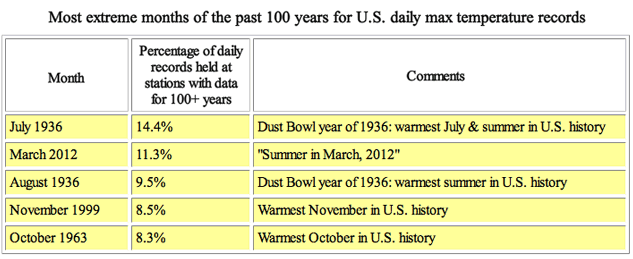March 2012 Warmest in United States History
March 2012 was the warmest March in the United States since record keeping began in 1895. It was also the second most extreme month for hot weather ever reported. In their monthly State of the Climate report The National Oceanic and Atmospheric Administration (NOAA) reported that the average temperature of 51.1° F (10.6° C) was 8.6° F warmer than the 20th century average for March and .5° F warmer than the previous warmest March in 1910. Of the more than 1,400 months that have passed since the United States weather records began in 1895, only one month -- January 2006 -- had a larger departure from its average temperature than March 2012. A remarkable 25 states east of the Rocky Mountains had their warmest March on record. An additional 15 states reported top-ten warmest March temperatures.
In Central Florida average monthly temperature departures for March 2012 were roughtly 4-6° F above normal ranking March 2012 in the top 10 warmest for Daytona Beach, Orlando, Melbourne, and Vero Beach.
Drought Conditions Continue to Worsen
March 2012 rainfall totals for the four main climate sites in Central Florida showed worsening drought conditions across the region. For a complete breakdown of the precipitation (or lack thereof) numbers visit the National Weather Service Forecast Office Melbourne website. Traveling across Central Florida the past few days I noticed more lakes and ponds completely dry. These are conditions I have not witnessed before.
 |
| Hot April Moonrise |
Most Daily Records Broken
of any month since the Dust Bowl
More daily high temperature records were broken in March in 2012 than for any month except July 1936. 11.3% of all daily high temperature records for the month of March in the U.S. are now held by the year 2012, for the 550 stations in NOAA's National Climatic Data Center database that have weather records extending back at least 100 years. The only month in U.S. history holding a higher percentage of daily temperatures records is July 1936. That month holds 14.4% of all the U.S. high temperature records for the month of July. That month occurred in the Dust Bowl summer of 1936, the hottest summer in U.S. history.
March Temperature Records Obliterated
Among the 15,000 daily records for warmth set in March 2012 were 21 truly astonishing ones: cases where the low temperature for the day beat the previous high temperature for the day. It is quite rare for a weather station with a 50-plus year period of data to break a daily temperature record by more than 10° F. During March, 2012, beating daily records by 10°- 20° F was commonplace, and NOAA lists 44 cases where a daily record was broken by more than 22° F. Extraordinarily, four stations broke a record for the date by 30° F or more. Canada holds the most freakish record of this nature during the March heat wave: Western Head, Nova Scotia hit 29.2° C (85° F) on March 22, breaking their previous record for the date (10.6° C in 1969) by 18.6° C (33.5°F). Canada also had several stations break their all-time warmest April temperature records a month early, in March.
Last 12 months were the warmest on record
The 12-month period (April 2011-March 2012), includes the second hottest summer (June-August) and fourth warmest winter (December-February). It was the warmest such period for the contiguous United States. The year-to-date period (January-March) has also been the warmest on record. NOAA's U.S. Climate Extremes Index, an index that tracks the highest 10 percent and lowest 10 percent of extremes in temperature, precipitation, and drought, was 39%, nearly twice the long-term average and the highest value on record for the January-March period. The principal factor was the large area experiencing extremes in warm daily maximum and minimum temperatures.
 |
| Hot sun on an Easter Lily |
Meteorological March Madness 2012
Dr. Martin Hoerling of NOAA's Earth System Research Laboratory in Boulder has posted a thorough analysis of the heat wave, which he calls, "Meteorological March Madness 2012." He explains that the event was probably a natural phenomenon, one that was predicted more than a month in advance by NOAA's long-range CFS computer model. A similar, though not as intense heat wave occurred in March 1910. However, he notes that the approximate 0.5 - 1° C warming in the Ohio Valley/Midwest U.S. in recent decades--due to human-caused emission of heat trapping gases like carbon dioxide--has significantly increased the odds of major heat waves occurring. He speculates that the odds of a 1-in-40 year heat wave in the Midwest may have increased by about 50% due to human-caused global warming, but that we really don't know how much global warming may have increased the odds of the March 2012 heat wave, "This issue of estimating reliable statistics of extreme, rare events continues to be a matter of active research." He estimates that human-caused global warming likely increased the intensity of the March 12 - 23, 2012 heat wave by about 5 - 10%, and concludes by saying, "The probability of heatwaves is growing as [human-caused] warming continues to progress. But there is always the randomness." |
| Hot Moon |



